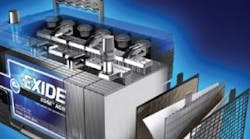Start-stop puts a strain on battery technology
Europeans already know that shutting off your engine at a stop light can improve fuel economy by as much as 15%. The stop-start technology that automates this process has been available there for a few years. But stop-start is easy to implement with the manual transmissions that characterize most European vehicles, less so on the automatics which account for 90% of North American sales.
Nevertheless, stop-start is coming to the U.S. General Motors will be among the first automakers to make a stop-start system, called eAssist, a standard feature. It will appear on 2012 Buick LaCrosse sedan and will be an option on the midsize 2012 Regal.
But several automotive technologies must change to make stop-start practical. Starters, for example, must be beefed up to handle more frequent usage. More problematic are vehicle batteries; ordinary flooded lead-acid units don't stand up well to the dramatically higher rate of usage imposed by stop-start.
Conventional lead-acids are built to withstand high levels of overcharge and generally spend most of their time at 100% charge. But batteries in vehicles equipped with start-stop spend much more of their time in a state of partial discharge. This condition promotes build-up of lead sulfate on the battery's negative plate. The material gets produced during discharge as soluble lead ions combine with sulfate to form lead sulfate crystals.
When conventional lead-acid batteries generate lead sulfate, much of the material gets dissolved to reform soluble lead ions in a step referred to as dissolution. These soluble lead ions eventually gain gain electrons and get converted back to lead a step referred to as deposition.
Unfortunately, this two-step dissolution/deposition process limits the number of charge cycles and the amount of charge lead–acid batteries can accept because it limits the availability of the reaction intermediate – soluble lead ions. The lead sulfate crystals in the negative plate are initially small.
However, after repetitive cycling, these crystals become larger and eventually get to a size that is difficult to dissolve. This not only limits the number of charge cycles that are practical but also boosts the amount of time necessary to charge the battery.
Battery makers have come up with different construction techniques to minimize the impact of being in a near-constant state of partial discharge. "One of the big things we are working on is charge acceptance. We have been able to improve charge acceptance by a factor of three but we want to further improve the charging time. To that end we've increased our R&D budget by 50% compared to 2.5 years ago to focus on developing batteries for stop start market," says Exide Technologies VP Global Research, Development and Engineering Paul Cheeseman. Exide recently produced its 2,500,000th battery for stop-start vehicles (called micro-hybrids) in Europe. These batteries use Absorbent Glass Mat (AGM) technology as a means of handling high-frequency stopping, starting, and regenerative braking. The mat in AGM refers to a separator that is analogous to a sponge or squeegee that is squeezed between the negative and the positive plates. The battery components are under compression.
Cheeseman is a bit cagey about exactly how the compression structure reduces the formation of lead sulfate but says it is one of the factors that gives the battery a long life under stop-start conditions.
Another battery aimed at stop-start uses is dubbed the PbC battery by its developer, Axion Power International Inc. Axion says the battery combines a conventional lead–acid battery lead dioxide positive electrode, with a proprietary activated carbon supercapacitor-like negative electrode. The positive electrode involves the standard reaction of lead dioxide to lead sulfate, while the negative electrode energy storage process is based on highly reversible non-Faradaic, electrostatic, ion adsorption at the carbon surface.
Axion says most components of the PcC battery resemble those of conventional lead-acids except for a proprietary microporous activated carbon negative electrode. The company reports a stable charge time of below 50 sec over 100,000 HEV cycles, or eight years of equivalent vehicle operation.
Stop-start batteries to date have targeted the European market. But they might not be quite right for U.S. vehicles implementing this technology. "Stop-start is going to be executed in the U.S. differently than in Europe because the driving is different," says Exide's Cheeseman. "For a large part of the U.S., stop-start is not going to be as relevant."
Exide Technologies: http://www.exide.com/
Axion Power International Inc.: http://www.axionpower.com/
Our sister site EngineeringTV.com did a short video on other aspects of start-stop technology: http://www.engineeringtv.com/video/Densos-Fuel-Saving-Engine-Start;NAIAS-2011-Videos
